Sustainable Development in Basic Education Sciences in Portugal—Perspective of Official Curriculum Documents
Abstract
:1. Introduction
“Living better on planet Earth presupposes critical and thoughtful human intervention, aiming at sustainable development that, considering the Science, Technology, Society and Environment interaction, is based on social and ethical options and on scientific knowledge, enlightened on the dynamics of systemic relationships that characterize the natural world and on the influence of these relationships on individual and community health” [8].(p. 133)
“… reference for the decisions to be adopted by decision-makers and educational actors at the level of educational establishments and entities responsible for educational policies, constituting a common matrix for all schools and educational offerings within the scope of compulsory education, namely at the curricular level, in the planning, implementation, and internal and external evaluation of teaching and learning” [12].(p. 6)
2. Methodology
3. Results
3.1. References by Dimension, Category, and Subcategory of Analysis of the Entire Corpus
3.2. References of Transversal Documents (Documents 10 and 11 of the Corpus)
3.3. References of “Essential Learning” (Documents 1 to 9 of the Corpus)
4. Discussion
5. Conclusions
Author Contributions
Funding
Institutional Review Board Statement
Informed Consent Statement
Data Availability Statement
Acknowledgments
Conflicts of Interest
References
- United Nations. Transforming Our World: The 2030 Agenda for Sustainable Development. Available online: https://www.un.org/ga/search/view_doc.asp?symbol=A/RES/70/1&Lang=E (accessed on 3 March 2022).
- UNESCO and Sustainable Development Goals. Available online: https://en.unesco.org/sustainabledevelopmentgoals (accessed on 3 March 2022).
- DGE—ODS. Available online: https://www.dge.mec.pt/objetivos-de-desenvolvimento-sustentavel-ods (accessed on 3 March 2022).
- ME—Decreto-Lei No. 286/89. Available online: https://dre.pt/dre/detalhe/decreto-lei/286-1989-618310 (accessed on 3 March 2022).
- ME. Orientações Curriculares para a Educação Pré-Escolar. 1997. Available online: https://www.dge.mec.pt/sites/default/files/Basico/orientacoes_curriculares_pre_escolar.pdf (accessed on 3 March 2022).
- ME—Decreto-Lei No. 6/2001. Available online: https://dre.pt/dre/detalhe/decreto-lei/6-2001-338986 (accessed on 3 March 2022).
- ME—Decreto-Lei No. 74/2004. Available online: https://dre.pt/dre/detalhe/decreto-lei/74-2004-210801 (accessed on 3 March 2022).
- Ministério da Educação. Currículo Nacional do Ensino Básico—Competências Essenciais; Ministério da Educação: Lisboa, Portugal, 2013; p. 241.
- ME—Despacho No. 17169/2011. Available online: https://dre.pt/dre/detalhe/despacho/17169-2011-1011055 (accessed on 3 March 2022).
- DGE—Metas de Aprendizagem. Available online: http://www.dge.mec.pt/documentos-curriculares-em-vigor (accessed on 3 March 2022).
- MEC—Despacho No. 5122/2013. Available online: https://www.dge.mec.pt/sites/default/files/Basico/Legislacao/despacho_5122_2013.pdf (accessed on 3 March 2022).
- Ministério da Educação/Direção Geral da Educação (Ed.) Perfil dos Alunos à Saída da Escolaridade Obrigatória; Editorial do Ministério da Educação e Ciência: Lisboa, Portugal, 2017; p. 33. Available online: https://dge.mec.pt/sites/default/files/Curriculo/Projeto_Autonomia_e_Flexibilidade/perfil_dos_alunos.pdf (accessed on 3 March 2022).
- Monteiro, R.; Ucha, L.; Alvarez, T.; Neves, M.J.; Silva, M.; Prazeres, V.; Diniz, F.; Vieira, C.; Gonçalves, L.M.; Araújo, H.C.; et al. Estratégia Nacional de Educação para a Cidadania; XXI Governo Constitucional: Lisboa, Portugal, 2017; p. 15. Available online: https://dge.mec.pt/sites/default/files/Projetos_Curriculares/Aprendizagens_Essenciais/estrategia_cidadania_original.pdf (accessed on 3 March 2022).
- DGE. Referencial de Educação Ambiental para a Sustentabilidade para a Educação Pré-Escolar, o Ensino Básico e o Ensino Secundário; Ministério da Educação: Lisboa, Portugal, 2018; p. 123. Available online: https://www.dge.mec.pt/sites/default/files/ECidadania/Educacao_Ambiental/documentos/referencial_ambiente.pdf (accessed on 3 March 2022).
- DGE—Estratégia Nacional de Educação Ambiental. Available online: https://dre.pt/dre/detalhe/resolucao-conselho-ministros/100-2017-107669156 (accessed on 3 March 2022).
- ME—Despacho No. 6605-A/2021. Available online: https://files.dre.pt/2s/2021/07/129000001/0000200003.pdf (accessed on 3 March 2022).
- DGE—Aprendizagens Essenciais. Available online: https://www.dge.mec.pt/aprendizagens-essenciais-ensino-basico (accessed on 3 March 2022).
- Amado, J. Manual de Investigação Qualitativa em Educação, 3rd ed.; Imprensa da Universidade de Coimbra: Coimbra, Portugal, 2017. [Google Scholar] [CrossRef] [Green Version]
- Coutinho, C. Metodologia de Investigação em Ciências Sociais e Humanas: Teoria e Prática, 2nd ed.; Edições Almedina S. A.: Coimbra, Portugal, 2018. [Google Scholar]
- Bardin, L. Análise de Conteúdo; Edições 70: Lisboa, Portugal, 2014. [Google Scholar]
- Aprendizagens Essenciais de Estudo do Meio—1.° ano. Available online: http://www.dge.mec.pt/sites/default/files/Curriculo/Aprendizagens_Essenciais/1_ciclo/1_estudo_do_meio.pdf (accessed on 3 March 2022).
- Aprendizagens Essenciais de Estudo do Meio—2.° ano. Available online: http://www.dge.mec.pt/sites/default/files/Curriculo/Aprendizagens_Essenciais/1_ciclo/2_estudo_do_meio.pdf (accessed on 3 March 2022).
- Aprendizagens Essenciais de Estudo do Meio—3.° ano. Available online: http://www.dge.mec.pt/sites/default/files/Curriculo/Aprendizagens_Essenciais/1_ciclo/3_estudo_do_meio.pdf (accessed on 3 March 2022).
- Aprendizagens Essenciais de Estudo do Meio—4.° ano. Available online: http://www.dge.mec.pt/sites/default/files/Curriculo/Aprendizagens_Essenciais/1_ciclo/4_estudo_do_meio.pdf (accessed on 3 March 2022).
- Aprendizagens Essenciais de Ciências Naturais—5.° ano. Available online: http://www.dge.mec.pt/sites/default/files/Curriculo/Aprendizagens_Essenciais/2_ciclo/5_ciencias_naturais.pdf (accessed on 3 March 2022).
- Aprendizagens Essenciais de Ciências Naturais—6.° ano. Available online: http://www.dge.mec.pt/sites/default/files/Curriculo/Aprendizagens_Essenciais/2_ciclo/6_ciencias_naturais.pdf (accessed on 3 March 2022).
- Aprendizagens Essenciais de Ciências Naturais—7.° ano. Available online: http://www.dge.mec.pt/sites/default/files/Curriculo/Aprendizagens_Essenciais/3_ciclo/ciencias_naturais_3c_7a_ff.pdf (accessed on 3 March 2022).
- Aprendizagens Essenciais de Ciências Naturais—8.° ano. Available online: http://www.dge.mec.pt/sites/default/files/Curriculo/Aprendizagens_Essenciais/3_ciclo/ciencias_naturais_3c_8a_ff.pdf (accessed on 3 March 2022).
- Aprendizagens Essenciais de Ciências Naturais—9.° ano. Available online: http://www.dge.mec.pt/sites/default/files/Curriculo/Aprendizagens_Essenciais/3_ciclo/ciencias_naturais_3c_9a_ff.pdf (accessed on 3 March 2022).
- Sá, P.; João, P.; Rodrigues, A.V. Sustainable Development in Primary Education—A perspective from official Portuguese guiding documents. In Computer Supported Qualitative Research; WCQR: Kingsport, TN, USA, 2019; Advances in Intelligent Systems and Computing; Costa, P., Reis, L., Moreira, A., Eds.; Springer: Cham, Switzerland, 2020; pp. 262–273. [Google Scholar] [CrossRef]
- Amador, F.; Oliveira, C.B.P. Integrating Sustainability into the University: Past, Present and Future. In Sustainability Assessment Tools in Higher Education Institutions; Caeiro, S., Leal Filho, W., Jabbour, C., Azeiteiro, U., Eds.; Springer: Cham, Switzerland, 2013; pp. 65–78. [Google Scholar] [CrossRef]
- Sá, P. Educação para o Desenvolvimento Sustentável no 1°CEB: Contributos da Formação de Professores. Ph.D. Thesis, University of Aveiro, Aveiro, Portugal, 2008. [Google Scholar]
- Sá, P.; Lopes, J.B.; Martins, I.P. Sustentabilidade e Intercompreensão: Perspetivas e Contributos de um Centro de Investigação em Educação. Rev. Lusófona De Educ. 2019, 43, 91–107. [Google Scholar] [CrossRef]
- Mensah, J. Sustainable development: Meaning, history, principles, pillars, and implications for human action: Literature review. Cogent Soc. Sci. 2019, 5, 1–21. [Google Scholar] [CrossRef]
- UNESCO. Década da Educação das Nações Unidas para um Desenvolvimento Sustentável, 2005–2014: Documento Final do Esquema Internacional de Implementação; Organização das Nações Unidas para a Educação, a Ciência e a Cultura: Brasília, Brasil, 2005. [Google Scholar]
- Vala, J. A análise de conteúdo. In Metodología das Ciencias Sociais, 6th ed.; Silva, A.S., Pinto, J.M., Eds.; Edições Afrontamento: Porto, Portugal, 1986; pp. 101–128. [Google Scholar]
- UNESCO. United Nations Decade of Education for Sustainable Development (2005–2014): International Implementation Scheme; Section for Education for Sustainable Development; UNESCO: Paris, France, 2005; p. 31. [Google Scholar]
- Anyolo, E.O.; Kärkkäinen, S.; Keinonen, T. Implementing Education for Sustainable Development in Namibia: School Teachersí Perceptions and Teaching Practices. J. Teach. Educ. Sustain. 2018, 20, 64–81. [Google Scholar] [CrossRef] [Green Version]
- Araújo, M.; Pedrosa, M.A. Desenvolvimento Sustentável e Concepções de Professores de Biologia em Formação Inicial. Rev. Ens. 2014, 16, 71–83. [Google Scholar] [CrossRef]
- Bezeljak, P.; Scheuch, M.; Torkar, G. Understanding of Sustainability and Education for Sustainable Development among Pre-Service Biology Teachers. Sustainability 2020, 12, 6892. [Google Scholar] [CrossRef]
- Sund, P.; Gericke, N. Teaching contributions from secondary school subject areas to education for sustainable development—A comparative study of science, social science and language teachers. Environ. Educ. Res. 2020, 26, 772–794. [Google Scholar] [CrossRef]
- Werlen, B.; Osterbeek, L.; Henriques, M.H. 2016 International year of global understanding: Building bridges between global thinking and local actions. Episodes 2016, 39, 604–611. [Google Scholar] [CrossRef]
- García-González, E.; Jiménez-Fontana, R.; Azcárate, P. Education for Sustainability and the Sustainable Development Goals: Pre-Service Teachers’ Perceptions and Knowledge. Sustainability 2020, 12, 7741. [Google Scholar] [CrossRef]
- Niens, J.; Richter-Beuschel, L.; Stubbe, T.; Bögeholz, S. Procedural Knowledge of Primary School Teachers in Madagascar for Teaching and Learning towards Land-Use- and Health-Related Sustainable Development Goals. Sustainability 2021, 13, 9036. [Google Scholar] [CrossRef]
- Esteves, M.H. Manual Escolar e mudanças curriculares em Portugal: Percepção dos docentes de Geografia. Educação 2021, 46, 1–21. [Google Scholar] [CrossRef]

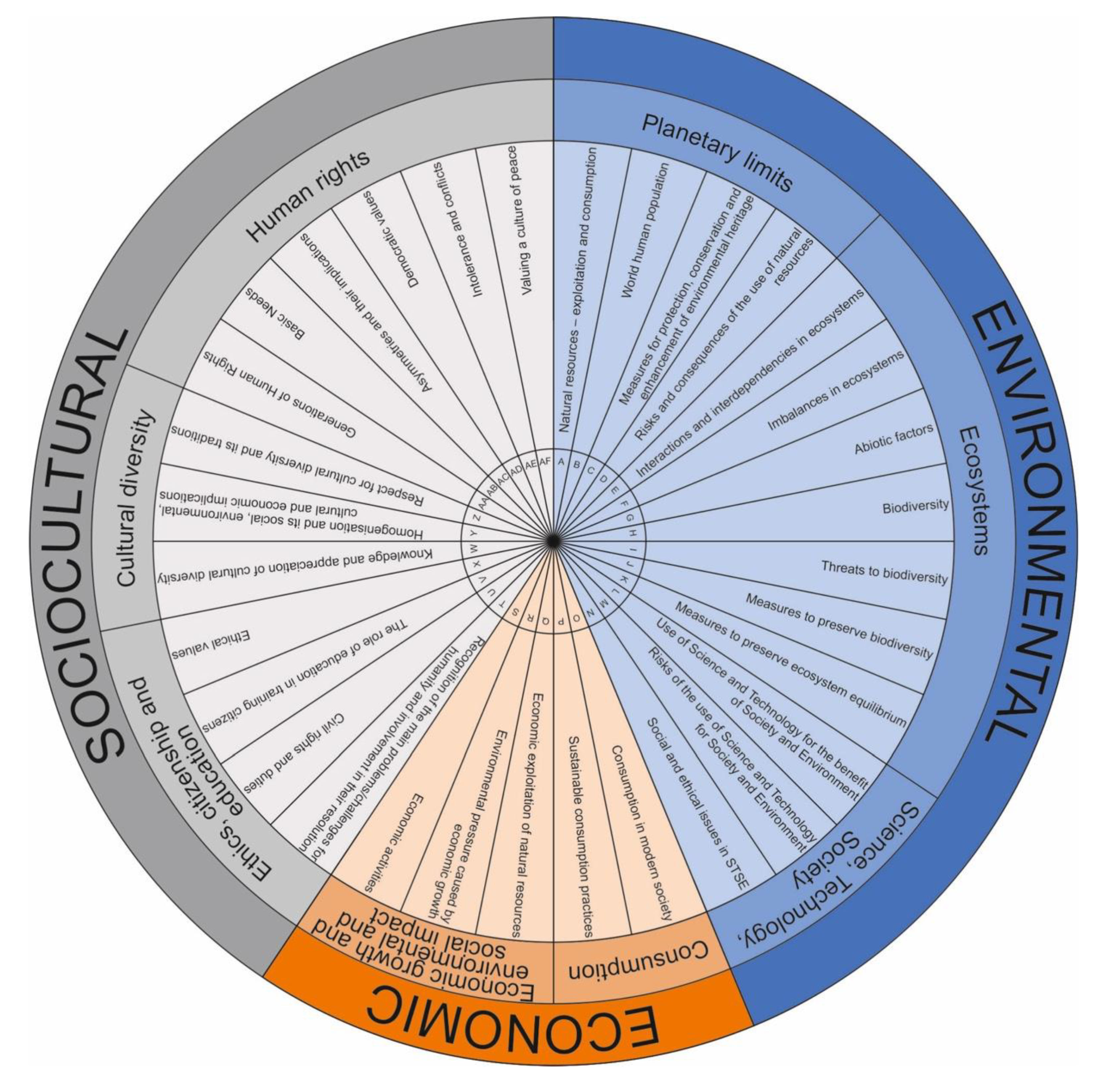
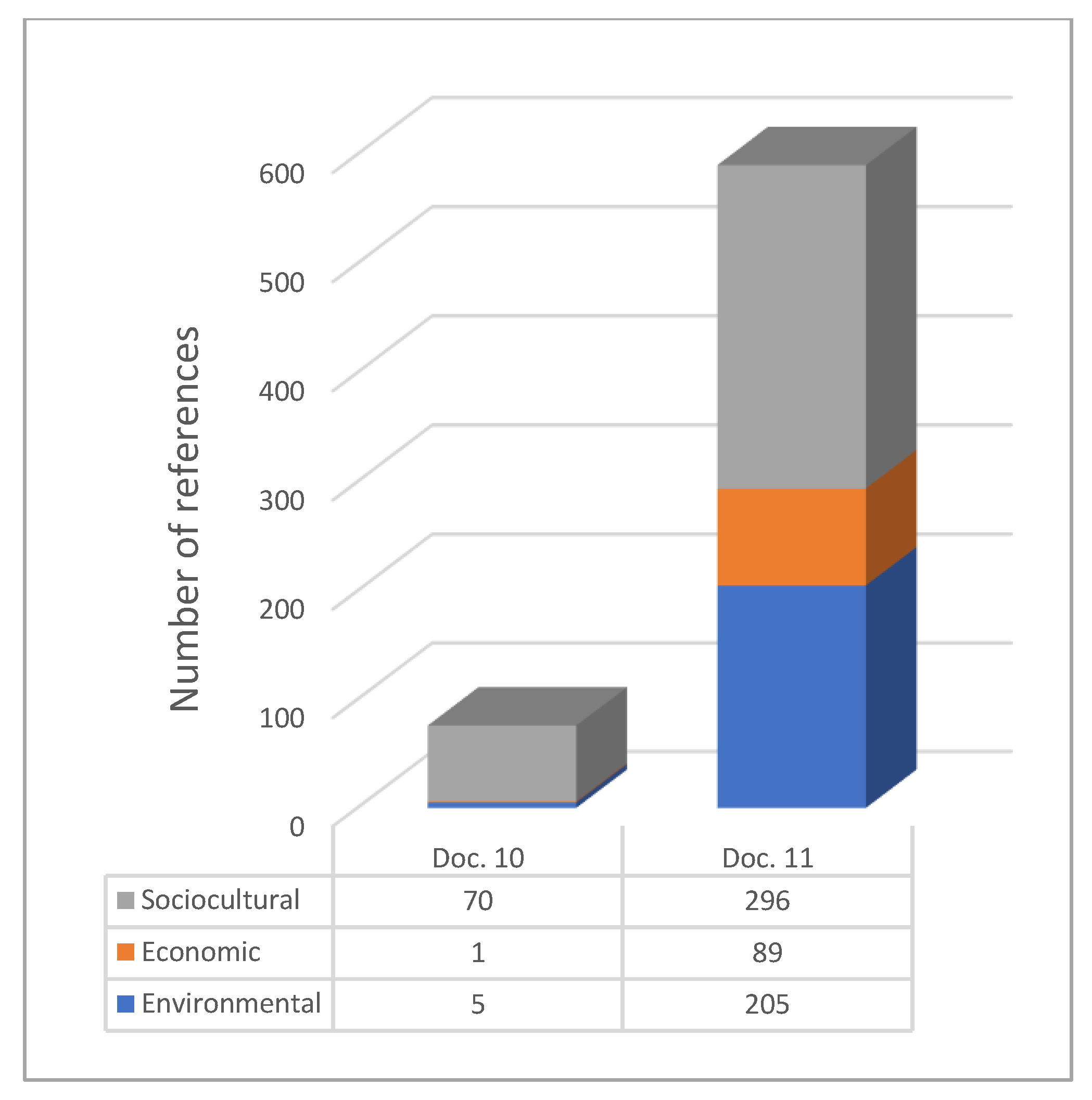
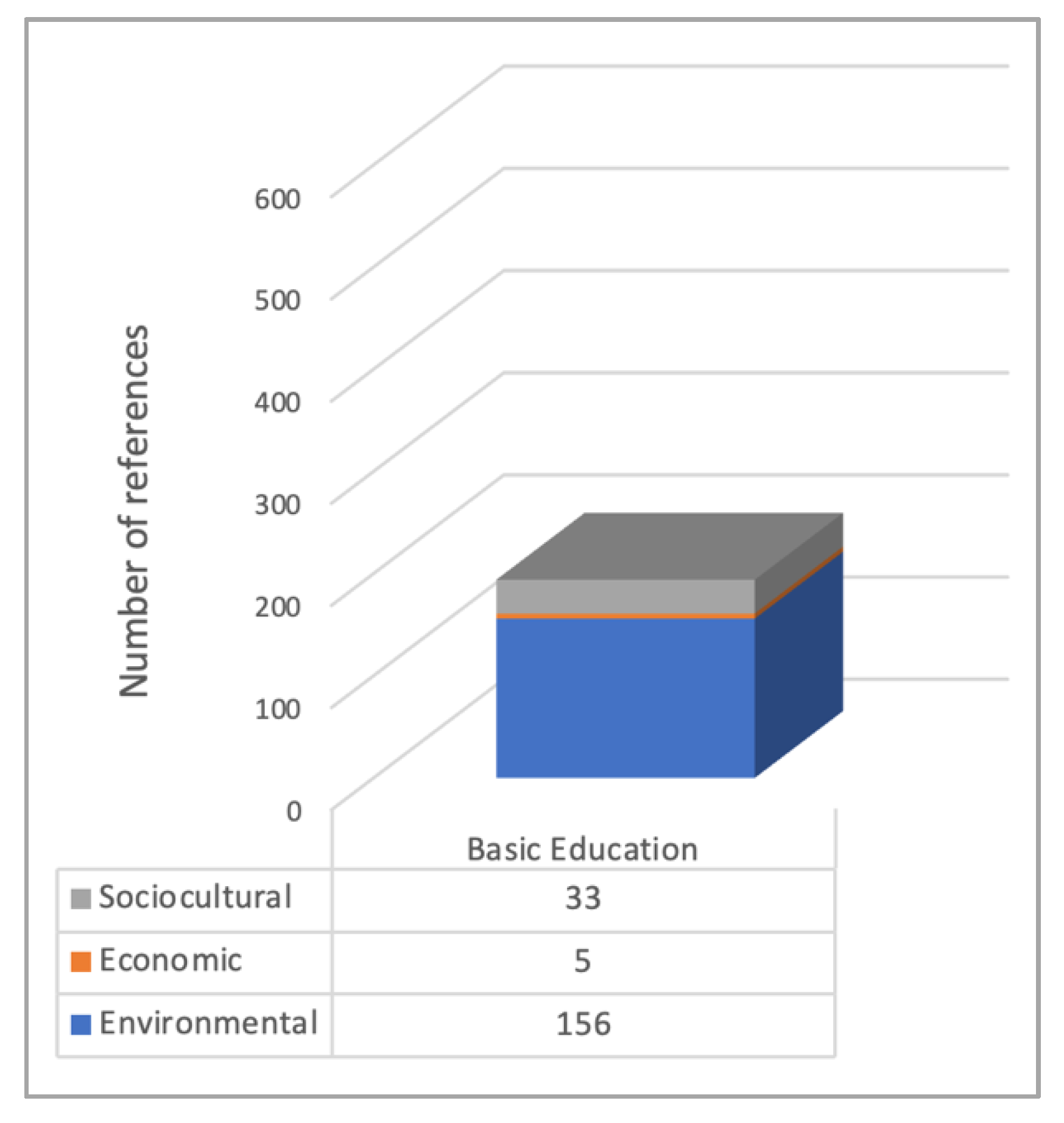
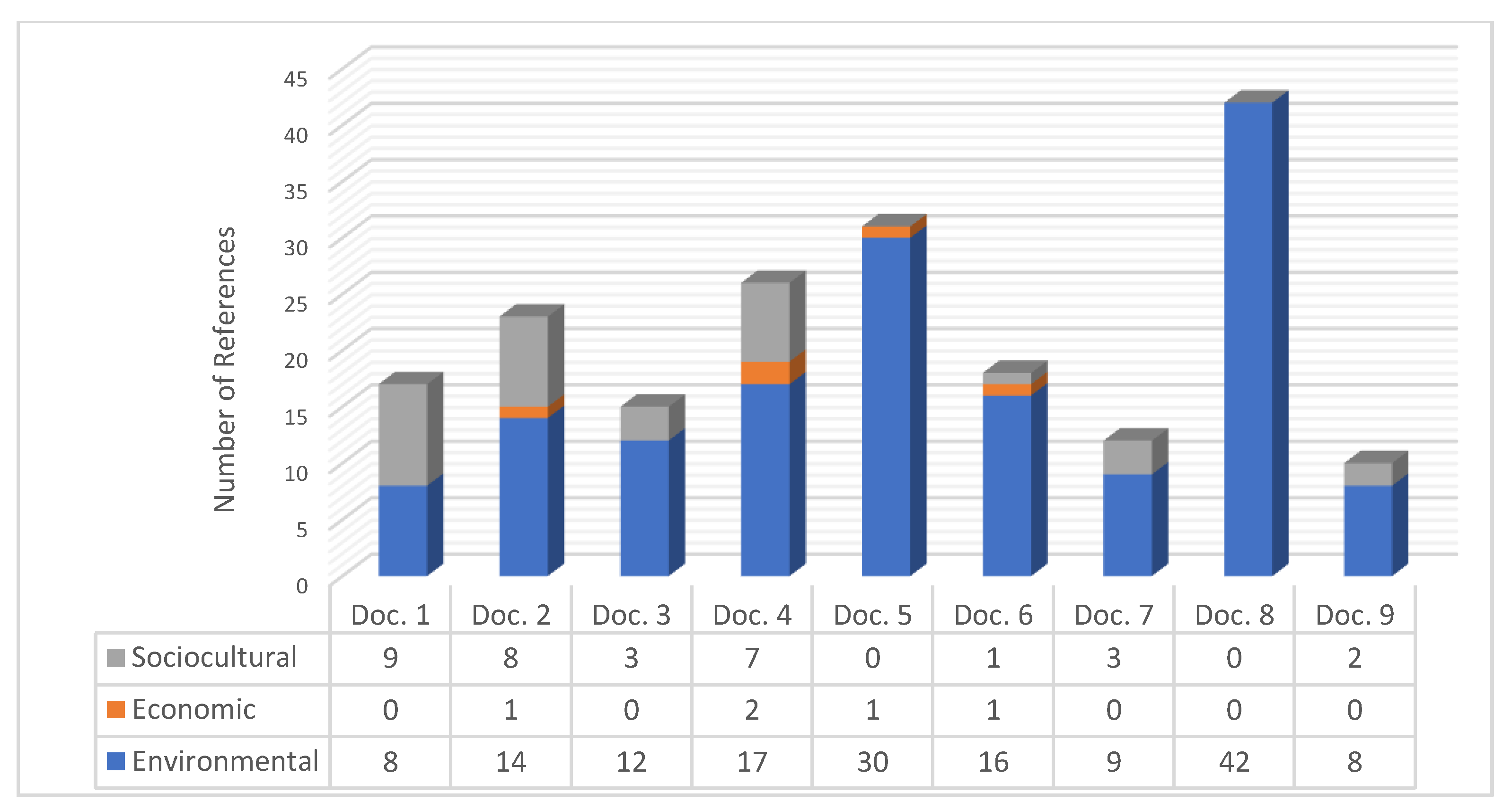
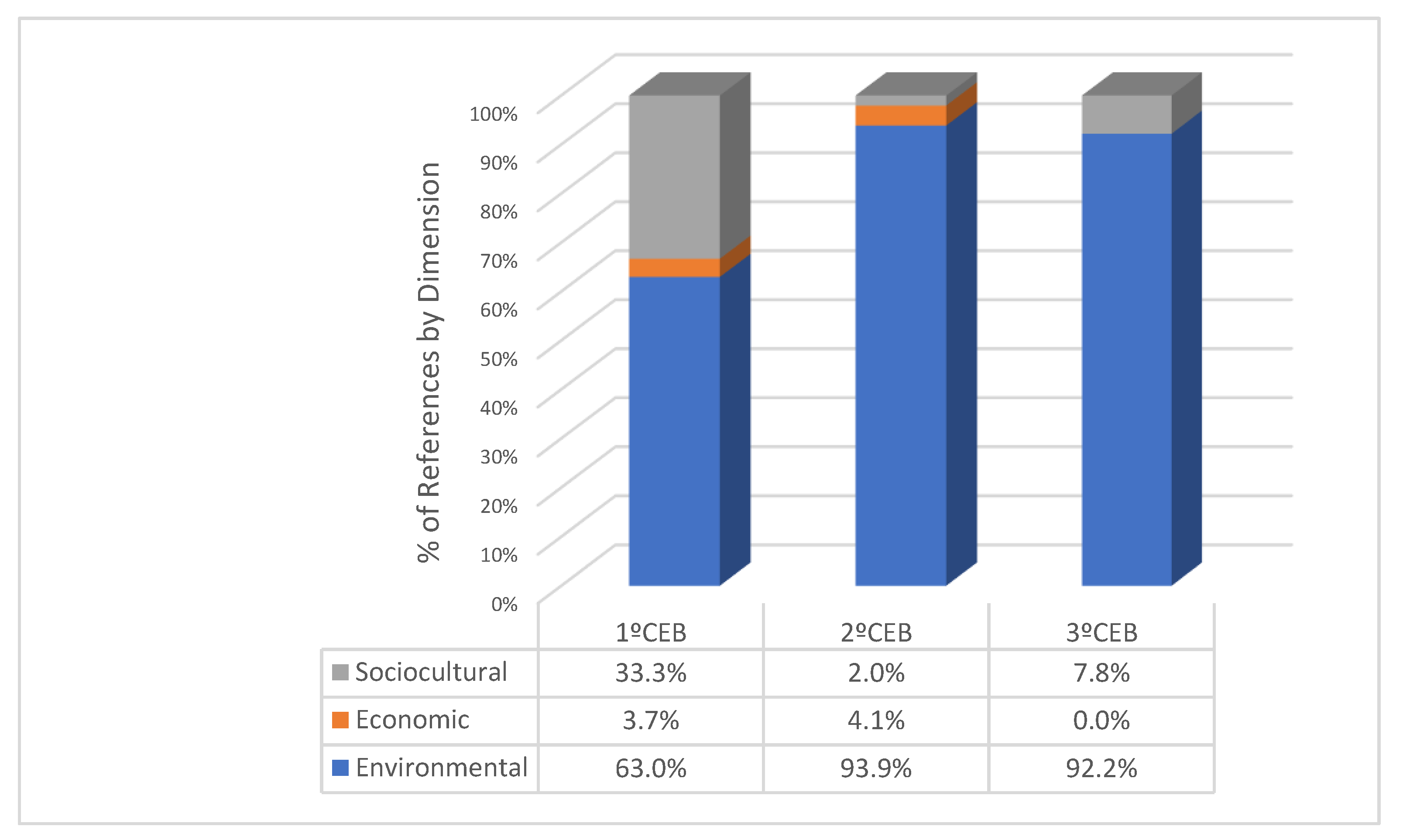
| Document Organization | Documents |
|---|---|
| Essential Learning | |
| Essential Learning. Environmental Studies. First grade [21] Essential Learning. Environmental Studies. Second grade [22] Essential Learning. Environmental Studies. Third grade [23] Essential Learning. Environmental Studies. Fourth grade [24] |
| Essential Learning. Natural Sciences. Fifth grade [25] Essential Learning. Natural Sciences. Sixth grade [26] |
| Essential Learning. Natural Sciences. Seventh grade [27] Essential Learning. Natural Sciences. Eighth grade [28] Essential Learning. Natural Sciences. Ninth grade [29] |
| Student Profile | Student Profile at Completion of Compulsory Education [13] |
| Environmental Education for Sustainability | Referential Environmental Education for Sustainability [15] |
| Code | Documents | Characterization |
|---|---|---|
| 1 | Essential Learning. Environmental Studies. First grade | Guiding document |
| 2 | Essential Learning. Environmental Studies. Second grade | Guiding document |
| 3 | Essential Learning. Environmental Studies. Third grade | Guiding document |
| 4 | Essential Learning. Environmental Studies. Fourth grade | Guiding document |
| 5 | Essential Learning. Natural Sciences. Fifth grade | Guiding document |
| 6 | Essential Learning. Natural Sciences. Sixth grade | Guiding document |
| 7 | Essential Learning. Natural Sciences. Seventh grade | Guiding document |
| 8 | Essential Learning. Natural Sciences. Eighth grade | Guiding document |
| 9 | Essential Learning. Natural Sciences. Ninth grade | Guiding document |
| 10 | Student Profile at Completion of Compulsory Education | Transversal document |
| 11 | Referential Environmental Education for Sustainability | Transversal document |
| Documents Analyzed | 1 | 2 | 3 | 4 | 5 | 6 | 7 | 8 | 9 | 10 | 11 | |
|---|---|---|---|---|---|---|---|---|---|---|---|---|
| E N V I R O N M E N T A L | Planetary Limits | 1 | 0 | 1 | 6 | 9 | 2 | 3 | 9 | 0 | 0 | 96 |
| A | 0 | 0 | 1 | 2 | 5 | 0 | 2 | 3 | 0 | 0 | 41 | |
| B | 0 | 0 | 0 | 1 | 0 | 0 | 0 | 0 | 0 | 0 | 12 | |
| C | 1 | 0 | 0 | 1 | 1 | 2 | 1 | 5 | 0 | 0 | 29 | |
| D | 0 | 0 | 0 | 2 | 3 | 0 | 0 | 1 | 0 | 0 | 14 | |
| Ecosystems | 2 | 11 | 7 | 8 | 19 | 7 | 1 | 30 | 0 | 0 | 98 | |
| E | 0 | 0 | 1 | 0 | 2 | 1 | 1 | 12 | 0 | 0 | 9 | |
| F | 0 | 0 | 1 | 2 | 0 | 0 | 0 | 4 | 0 | 0 | 6 | |
| G | 0 | 3 | 1 | 2 | 7 | 1 | 0 | 4 | 0 | 0 | 17 | |
| H | 2 | 4 | 1 | 3 | 8 | 3 | 0 | 4 | 0 | 0 | 26 | |
| I | 0 | 1 | 1 | 1 | 1 | 0 | 0 | 2 | 0 | 0 | 20 | |
| J | 0 | 2 | 1 | 0 | 0 | 1 | 0 | 0 | 0 | 0 | 18 | |
| K | 0 | 1 | 1 | 0 | 1 | 1 | 0 | 4 | 0 | 0 | 2 | |
| Science, Technology, and Society | 5 | 3 | 4 | 3 | 2 | 7 | 5 | 3 | 8 | 5 | 11 | |
| L | 5 | 2 | 3 | 3 | 2 | 5 | 5 | 1 | 7 | 4 | 11 | |
| M | 0 | 1 | 0 | 0 | 0 | 1 | 0 | 1 | 0 | 1 | 0 | |
| N | 0 | 0 | 1 | 0 | 0 | 1 | 0 | 1 | 1 | 0 | 0 | |
| E C O N O M I C | Consumption | 0 | 1 | 0 | 2 | 1 | 1 | 0 | 0 | 0 | 0 | 81 |
| O | 0 | 1 | 0 | 1 | 0 | 1 | 0 | 0 | 0 | 0 | 19 | |
| P | 0 | 0 | 0 | 1 | 1 | 0 | 0 | 0 | 0 | 0 | 62 | |
| Economic Growth and Environmental and Social Impacts | 0 | 0 | 0 | 0 | 0 | 0 | 0 | 0 | 0 | 1 | 8 | |
| Q | 0 | 0 | 0 | 0 | 0 | 0 | 0 | 0 | 0 | 0 | 3 | |
| R | 0 | 0 | 0 | 0 | 0 | 0 | 0 | 0 | 0 | 0 | 4 | |
| S | 0 | 0 | 0 | 0 | 0 | 0 | 0 | 0 | 0 | 1 | 1 | |
| S O C I O C U L T U R A L | Ethics, Citizenship, and Education | 4 | 2 | 2 | 0 | 0 | 1 | 3 | 0 | 2 | 33 | 262 |
| T | 2 | 2 | 1 | 0 | 0 | 0 | 0 | 0 | 0 | 7 | 50 | |
| U | 1 | 0 | 0 | 0 | 0 | 0 | 0 | 0 | 0 | 3 | 108 | |
| V | 0 | 0 | 1 | 0 | 0 | 1 | 3 | 0 | 2 | 23 | 104 | |
| X | 1 | 0 | 0 | 0 | 0 | 0 | 0 | 0 | 0 | 0 | 0 | |
| Cultural Diversity | 2 | 2 | 0 | 3 | 0 | 0 | 0 | 0 | 0 | 5 | 13 | |
| W | 1 | 2 | 0 | 1 | 0 | 0 | 0 | 0 | 0 | 2 | 6 | |
| Y | 0 | 0 | 0 | 0 | 0 | 0 | 0 | 0 | 0 | 0 | 0 | |
| Z | 1 | 0 | 0 | 2 | 0 | 0 | 0 | 0 | 0 | 3 | 7 | |
| Human Rights | 3 | 4 | 1 | 4 | 0 | 0 | 0 | 0 | 0 | 32 | 21 | |
| AA | 0 | 2 | 1 | 1 | 0 | 0 | 0 | 0 | 0 | 2 | 6 | |
| AB | 0 | 0 | 0 | 0 | 0 | 0 | 0 | 0 | 0 | 1 | 9 | |
| AC | 0 | 0 | 0 | 1 | 0 | 0 | 0 | 0 | 0 | 1 | 5 | |
| AD | 2 | 0 | 0 | 0 | 0 | 0 | 0 | 0 | 0 | 13 | 0 | |
| AE | 0 | 1 | 0 | 1 | 0 | 0 | 0 | 0 | 0 | 1 | 1 | |
| AF | 1 | 1 | 0 | 1 | 0 | 0 | 0 | 0 | 0 | 14 | 0 |
| DOCUMENTS | 1 | 2 | 3 | 4 | 5 | 6 | 7 | 8 | 9 | Total BE | 10 | 11 | Total Transversal Documents | Total |
|---|---|---|---|---|---|---|---|---|---|---|---|---|---|---|
| Environmental Dimension | 8 | 14 | 12 | 17 | 30 | 16 | 9 | 42 | 8 | 156 | 5 | 205 | 210 | 366 |
| Economic Dimension | 0 | 1 | 0 | 2 | 1 | 1 | 0 | 0 | 0 | 5 | 1 | 89 | 90 | 95 |
| Sociocultural Dimension | 9 | 8 | 3 | 7 | 0 | 1 | 3 | 0 | 2 | 33 | 70 | 296 | 366 | 399 |
| TOTAL | 17 | 23 | 15 | 26 | 31 | 18 | 12 | 42 | 10 | 194 | 76 | 590 | 666 | 860 |
Publisher’s Note: MDPI stays neutral with regard to jurisdictional claims in published maps and institutional affiliations. |
© 2022 by the authors. Licensee MDPI, Basel, Switzerland. This article is an open access article distributed under the terms and conditions of the Creative Commons Attribution (CC BY) license (https://creativecommons.org/licenses/by/4.0/).
Share and Cite
João, P.; Sá, P.; Henriques, M.H.; Rodrigues, A.V. Sustainable Development in Basic Education Sciences in Portugal—Perspective of Official Curriculum Documents. Sustainability 2022, 14, 5651. https://doi.org/10.3390/su14095651
João P, Sá P, Henriques MH, Rodrigues AV. Sustainable Development in Basic Education Sciences in Portugal—Perspective of Official Curriculum Documents. Sustainability. 2022; 14(9):5651. https://doi.org/10.3390/su14095651
Chicago/Turabian StyleJoão, Patrícia, Patrícia Sá, Maria Helena Henriques, and Ana V. Rodrigues. 2022. "Sustainable Development in Basic Education Sciences in Portugal—Perspective of Official Curriculum Documents" Sustainability 14, no. 9: 5651. https://doi.org/10.3390/su14095651
APA StyleJoão, P., Sá, P., Henriques, M. H., & Rodrigues, A. V. (2022). Sustainable Development in Basic Education Sciences in Portugal—Perspective of Official Curriculum Documents. Sustainability, 14(9), 5651. https://doi.org/10.3390/su14095651









